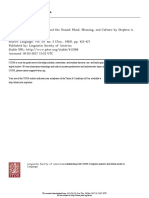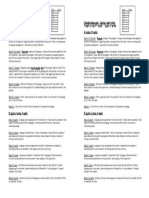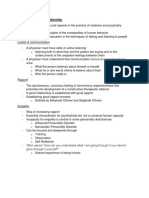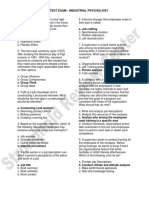Tnready Blueprint g3 Ela
Tnready Blueprint g3 Ela
Uploaded by
api-282869532Copyright:
Available Formats
Tnready Blueprint g3 Ela
Tnready Blueprint g3 Ela
Uploaded by
api-282869532Original Title
Copyright
Available Formats
Share this document
Did you find this document useful?
Is this content inappropriate?
Copyright:
Available Formats
Tnready Blueprint g3 Ela
Tnready Blueprint g3 Ela
Uploaded by
api-282869532Copyright:
Available Formats
TNReady 3rd Grade ELA Blueprint
Part I
# of items
# of
score
points
Part II
# of
items
# of
score
points
Total
# of
items
Writing
Focus and Organization
(1
Operational
, 1 Field
Test Item)
Reading Literature
13-16
17-21
13-16
Vocabulary
4-8
7-9
4-8
Development
Language and Style
Conventions
Reading
Reading Informational
Text
Total
0
1
13-16
24
35-45
17-21
46-56
13-16
36-46
Total #
of score
points
% of
Test
29
39%
11%
8
4
11%
5%
12%
17-21
23-28%
7-9
9-12%
41-51
17-21
70-80
61%
23-28%
100%
Additional Notes:
*The total number of score points does not match the total number of items. This is because some items may be worth
more than one point.
*All writing tasks on Part I require students to read one or more passages of appropriate grade level complexity. While
not directly assessed on Part I, the reading standards for each grade level are embedded in the design of the task and
are an important part of instruction throughout the year.
*The operational and field test writing tasks on Part I do not have to be taken on the same day. Each task is a separate
subtest and may be taken either on the same day or on consecutive school days. Districts will have the flexibility to
establish a testing schedule that best fits the needs of their schools.
3rd Grade Blueprint for Part I
(1 Operational, 1 Field Test Item)
Category
Writing:
Written Expression
(Prompt will align
to primarily one
writing standard
and also one or
more reading
standards.)
Writing:
Conventions
TOTALS
Standards
W.3.1
W.3.2
W.3.3
W.3.7
L.3.1
L.3.2
L.3.3
Write opinion pieces on topics or texts, supporting a point of view
with reasons. (Includes a-d.)
Write informative/explanatory texts to examine a topic and convey
ideas and information clearly. (Includes a-d.)
Write narratives to develop real or imagined experiences or events
using effective technique, descriptive details, and clear event
sequences. (Includes a-d.)
# of
Items
# of
Score
Points
20
(score points
from writing
rubric)
24
Conduct short research projects that build knowledge about a topic.
Demonstrate command of the conventions of standard English
grammar and usage when writing or speaking. (Includes a e.)
Demonstrate command of the conventions of standard English
capitalization, punctuation, and spelling when writing. (Includes a
e.)
Use knowledge of language and its conventions when writing,
speaking, reading, or listening. (Includes a-b.)
3rd Grade Blueprint for Part II
Category
Standards
RL.3.1
RL.3.2
Reading:
Reading
Literature
RL.3.3
RL.3.5
RL.3.6
RL.3.7
RL.3.9
RI.3.1
RI.3.2
Reading:
Reading
Informationa
l Text
RI.3.3
RI.3.5
RI.3.6
RI.3.7
RI.3.8
RI.3.9
RL.3.4
Reading:
Vocabulary
Writing:
Conventions
TOTALS
RI.3.4
L.3.4
L.3.5
L.3.1
L.3.2
L.3.3
Ask and answer questions to demonstrate understanding of a text, referring
explicitly to the text as the basis for the answers.
Recount stories, including fables, folktales, and myths from diverse cultures;
determine the central message, lesson, or moral and explain how it is conveyed
through key details in the text.
Describe characters in a story (e.g., their traits, motivations, or feelings) and
explain how their actions contribute to the sequence of events.
Refer to parts of stories, dramas, and poems when writing or speaking about a
text, using terms such as chapter, scene, and stanza; describe how each
successive part builds on earlier sections.
Distinguish their own point of view from that of the narrator or those of the
characters.
Explain how specific aspects of a text's illustrations contribute to what is
conveyed by the words in a story (e.g., create mood, emphasize aspects of a
character or setting).
Compare and contrast the themes, settings, and plots of stories written by the
same author about the same or similar characters (e.g., in books from a series).
Ask and answer questions to demonstrate understanding of a text, referring
explicitly to the text as the basis for the answers.
Determine the main idea of a text; recount the key details and explain how they
support the main idea.
Describe the relationship between a series of historical events, scientific ideas or
concepts, or steps in technical procedures in a text, using language that pertains
to time, sequence, and cause/effect.
Use text features and search tools (e.g., key words, sidebars, hyperlinks) to locate
information relevant to a given topic efficiently.
Distinguish their own point of view from that of the author of a text.
Use information gained from illustrations (e.g., maps, photographs) and the
words in a text to demonstrate understanding of the text (e.g., where, when, why,
and how key events occur).
Describe the logical connection between particular sentences and paragraphs in a
text (e.g., comparison, cause/effect, first/second/third in a sequence).
Compare and contrast the most important points and key details presented in
two texts on the same topic.
Determine the meaning of words and phrases as they are used in a text,
distinguishing literal from nonliteral language.
Determine the meaning of general academic and domain-specific words and
phrases in a text relevant to a grade 3 topic or subject area.
Determine or clarify the meaning of unknown and multiple-meaning words and
phrases based on grade 5 reading and content, choosing flexibly from a range of
strategies. (Includes a-c.)
Demonstrate understanding of figurative language, word relationships, and
nuances in word meanings. (Includes a-c.)
Demonstrate command of the conventions of standard English grammar and
usage when writing or speaking. (Includes a e.)
Demonstrate command of the conventions of standard English capitalization,
punctuation, and spelling when writing. (Includes a e.)
Use knowledge of language and its conventions when writing, speaking, reading,
or listening. (Includes a-b.)
# of
Items
# of
Score
Points
13-16
17-21
13-16
17-21
4-8
7-9
35-45
46-56
3rd Grade Blueprint
Includes Part I and Part II
Category
Writing:
Written
Expression
(Prompt will align
to primarily one
writing standard
and also one or
more reading
standards.)
Writing:
Conventions
Standards
W.3.1
W.3.2
W.3.3
W.3.7
L.3.1
L.3.2
L.3.3
RL.3.1
RL.3.2
Reading:
Reading
Literature
RL.3.3
RL.3.5
RL.3.6
RL.3.7
RL.3.9
RI.3.1
RI.3.2
Reading:
Reading
Informational
Text
RI.3.3
RI.3.5
RI.3.6
RI.3.7
RI.3.8
RI.3.9
Write opinion pieces on topics or texts, supporting a point of view with reasons.
(Includes a-d.)
Write informative/explanatory texts to examine a topic and convey ideas and
information clearly. (Includes a-d.)
Write narratives to develop real or imagined experiences or events using
effective technique, descriptive details, and clear event sequences. (Includes ad.)
Conduct short research projects that build knowledge about a topic.
Demonstrate command of the conventions of standard English grammar and
usage when writing or speaking. (Includes a-e.)
Demonstrate command of the conventions of standard English capitalization,
punctuation, and spelling when writing. (Includes a-e.)
Use knowledge of language and its conventions when writing, speaking, reading,
or listening. (Includes a-b.)
Ask and answer questions to demonstrate understanding of a text, referring
explicitly to the text as the basis for the answers.
Recount stories, including fables, folktales, and myths from diverse cultures;
determine the central message, lesson, or moral and explain how it is conveyed
through key details in the text.
Describe characters in a story (e.g., their traits, motivations, or feelings) and
explain how their actions contribute to the sequence of events.
Refer to parts of stories, dramas, and poems when writing or speaking about a
text, using terms such as chapter, scene, and stanza; describe how each
successive part builds on earlier sections.
Distinguish their own point of view from that of the narrator or those of the
characters.
Explain how specific aspects of a text's illustrations contribute to what is
conveyed by the words in a story (e.g., create mood, emphasize aspects of a
character or setting).
Compare and contrast the themes, settings, and plots of stories written by the
same author about the same or similar characters (e.g., in books from a series).
Ask and answer questions to demonstrate understanding of a text, referring
explicitly to the text as the basis for the answers.
Determine the main idea of a text; recount the key details and explain how they
support the main idea.
Describe the relationship between a series of historical events, scientific ideas or
concepts, or steps in technical procedures in a text, using language that pertains
to time, sequence, and cause/effect.
Use text features and search tools (e.g., key words, sidebars, hyperlinks) to
locate information relevant to a given topic efficiently.
Distinguish their own point of view from that of the author of a text.
Use information gained from illustrations (e.g., maps, photographs) and the
words in a text to demonstrate understanding of the text (e.g., where, when,
why, and how key events occur).
Describe the logical connection between particular sentences and paragraphs in
a text (e.g., comparison, cause/effect, first/second/third in a sequence).
Compare and contrast the most important points and key details presented in
4
# of
Items
% of
Score
Points
27%
5
(+ 4 pts
from
rubric)
12%
13-16
23-28%
13-16
23-28%
RL.3.4
Reading:
Vocabulary
TOTALS
RI.3.4
L.3.4
L.3.5
two texts on the same topic.
Determine the meaning of words and phrases as they are used in a text,
distinguishing literal from nonliteral language.
Determine the meaning of general academic and domain-specific words and
phrases in a text relevant to a grade 3 topic or subject area.
Determine or clarify the meaning of unknown and multiple-meaning words and
phrases based on grade 5 reading and content, choosing flexibly from a range of
strategies. (Includes a-c.)
Demonstrate understanding of figurative language, word relationships, and
nuances in word meanings. (Includes a-c.)
4-8
9-12%
36-46
100%
You might also like
- Performance EvaluationDocument3 pagesPerformance EvaluationFlorida Banzuelo Villanueva67% (3)
- Tej Dosa Letter 24Document19 pagesTej Dosa Letter 24Atilla NoNo ratings yet
- Critique JoyDocument6 pagesCritique JoySara AnwarNo ratings yet
- ReadyGEN Vertical Standards Maps - Grade 3Document12 pagesReadyGEN Vertical Standards Maps - Grade 3Will KirbyNo ratings yet
- Grade Forensic Anthropology Unit OutlineDocument7 pagesGrade Forensic Anthropology Unit OutlinebarriedonohueNo ratings yet
- Fourth MO Learning Standards LA1Document4 pagesFourth MO Learning Standards LA1Shawn NguyenNo ratings yet
- Common Core State Standards For English Language Arts: Grade 3: Reading LiteratureDocument16 pagesCommon Core State Standards For English Language Arts: Grade 3: Reading LiteraturejumpinglotusNo ratings yet
- Tnready Blueprint g4 ElaDocument6 pagesTnready Blueprint g4 Elaapi-282869532No ratings yet
- Tnready Blueprint g5 ElaDocument5 pagesTnready Blueprint g5 Elaapi-282869532No ratings yet
- Tnready Blueprint g8 ElaDocument5 pagesTnready Blueprint g8 Elaapi-282869532No ratings yet
- Tnready Blueprint g5 ElaDocument5 pagesTnready Blueprint g5 Elaapi-266656006No ratings yet
- Third Ela StandardsDocument4 pagesThird Ela Standardsapi-233655908No ratings yet
- E/LA Common Core Standards For Reading Grade 3: Key Ideas and Details - Anchor StandardsDocument5 pagesE/LA Common Core Standards For Reading Grade 3: Key Ideas and Details - Anchor StandardsPatti Kendrick WhatleyNo ratings yet
- Unit 1 Curriculum Map: SurvivalDocument6 pagesUnit 1 Curriculum Map: SurvivalNomadic EdventuresNo ratings yet
- 3rd Ela PlacematDocument1 page3rd Ela Placematapi-276971164No ratings yet
- Eighth Ela StandardsDocument4 pagesEighth Ela Standardsapi-233655908No ratings yet
- Common Core - ELA Standards - NutshellDocument8 pagesCommon Core - ELA Standards - Nutshelldraya3No ratings yet
- Fourth Ela StandardsDocument4 pagesFourth Ela Standardsapi-233655908No ratings yet
- ELA Grade 4 Standards PDFDocument6 pagesELA Grade 4 Standards PDFRuthelyn TurnerNo ratings yet
- StoryTown CC 3 Reverse1Document41 pagesStoryTown CC 3 Reverse1Shirley Fennessey100% (1)
- Fifth Ela StandardsDocument4 pagesFifth Ela Standardsapi-233655908No ratings yet
- Reading Standard Articulated by Grade Level Grade 10 Strand 1: Reading ProcessDocument4 pagesReading Standard Articulated by Grade Level Grade 10 Strand 1: Reading ProcessMa2FahriNo ratings yet
- Seventh Ela StandardsDocument3 pagesSeventh Ela Standardsapi-233655908No ratings yet
- 2014-15 SyllabusDocument33 pages2014-15 Syllabusapi-263396905No ratings yet
- Ela Grade 3 StandardsDocument6 pagesEla Grade 3 Standardsapi-266473918No ratings yet
- Long Term Planning With ELA Common Core Standards Grades K-5Document27 pagesLong Term Planning With ELA Common Core Standards Grades K-5April WalkerNo ratings yet
- Dornan English Grade 8 Curriculum MapDocument12 pagesDornan English Grade 8 Curriculum Mapapi-340615073100% (1)
- Commoncore 910Document7 pagesCommoncore 910api-235195700No ratings yet
- Reading Standards For LiteratureDocument9 pagesReading Standards For Literatureapi-290998130No ratings yet
- Common Core ELA Grade3 StandardsDocument6 pagesCommon Core ELA Grade3 Standardscflo2100% (1)
- 10th Grade Ela Pacing GuideDocument5 pages10th Grade Ela Pacing Guideapi-233366429No ratings yet
- Grade 3 Scope SequenceDocument9 pagesGrade 3 Scope Sequenceapi-237769293No ratings yet
- RL.9-10.1: Cite Strong and Thorough: Unit 1 Common Core Standards and ACT SkillsDocument5 pagesRL.9-10.1: Cite Strong and Thorough: Unit 1 Common Core Standards and ACT Skillsapi-145657165No ratings yet
- Assessing Reading by H. Douglas Brown: Ik Rimawita M.Ku RN Ia Ju Lia Nta VannidevarizalDocument40 pagesAssessing Reading by H. Douglas Brown: Ik Rimawita M.Ku RN Ia Ju Lia Nta VannidevarizalRedha ShafiraNo ratings yet
- 3rd Grade Scope and Sequence FinalDocument6 pages3rd Grade Scope and Sequence Finalapi-259785027No ratings yet
- Dps Grade 4 Ela Unit Map 4 1Document7 pagesDps Grade 4 Ela Unit Map 4 1api-264363149No ratings yet
- Elayear-At-A-Glance 3rdgradebyquarterDocument18 pagesElayear-At-A-Glance 3rdgradebyquarterapi-320723676No ratings yet
- 4th Ela PlacematDocument1 page4th Ela Placematapi-276971164No ratings yet
- Assessment Portfolio - HendersonDocument18 pagesAssessment Portfolio - Hendersonapi-250677904No ratings yet
- Unit - Unit III - The Lens of History - 20201219165635Document10 pagesUnit - Unit III - The Lens of History - 20201219165635Ashley PérezNo ratings yet
- LIN 23-24 Span 1 SyllabusDocument12 pagesLIN 23-24 Span 1 SyllabusTunay ArıcıNo ratings yet
- English Language Arts and Literacy in History/Social Studies & Science and Technical SubjectsDocument33 pagesEnglish Language Arts and Literacy in History/Social Studies & Science and Technical SubjectsSteph BorinagaNo ratings yet
- 3rd Grade Standards UnpackedDocument5 pages3rd Grade Standards Unpackedapi-256234399No ratings yet
- Unit Plan Template 2014 Almeziab 2Document3 pagesUnit Plan Template 2014 Almeziab 2api-307898964No ratings yet
- Grade: Language ArtsDocument12 pagesGrade: Language Artsjan4dyce_981645084No ratings yet
- 5 Ela Ccsschecklist 5thgradeDocument5 pages5 Ela Ccsschecklist 5thgradeapi-246981549No ratings yet
- 5th Grade La AkssDocument6 pages5th Grade La Akssapi-239864970No ratings yet
- Unit - Unit 1 - Rites of PassageDocument21 pagesUnit - Unit 1 - Rites of PassageYasin KhlifiNo ratings yet
- Second Ela StandardsDocument3 pagesSecond Ela Standardsapi-233655908No ratings yet
- 5th Grade Common Core/State ELA Standards Reporting Map: Quarter Strand. # StandardDocument4 pages5th Grade Common Core/State ELA Standards Reporting Map: Quarter Strand. # Standardmrkball100% (1)
- Thinglink Lesson PlanDocument7 pagesThinglink Lesson Planapi-247714219No ratings yet
- School Language FormDocument12 pagesSchool Language Formhk4d5t72ttNo ratings yet
- Summary of Assesing Writing by BrownDocument6 pagesSummary of Assesing Writing by BrownIsaWinehouseNo ratings yet
- Grade 4 Common CoreDocument12 pagesGrade 4 Common Coreapi-238597060No ratings yet
- English Language Arts - Grade 8 Standards: Students Spend A Majority of Time Immersed in Quality Texts and TasksDocument7 pagesEnglish Language Arts - Grade 8 Standards: Students Spend A Majority of Time Immersed in Quality Texts and Tasksapi-327134647No ratings yet
- q4 StandardsDocument3 pagesq4 Standardsapi-248799070No ratings yet
- 10-H Curriculum Map - American Literature Semester 1Document9 pages10-H Curriculum Map - American Literature Semester 1hgtfrtgyhuijkmlnbNo ratings yet
- Common Core FrameworkDocument90 pagesCommon Core FrameworkchmazuraNo ratings yet
- Regents Exams and Answers: English Revised EditionFrom EverandRegents Exams and Answers: English Revised EditionNo ratings yet
- A Non-Freaked Out Guide to Teaching the Common Core: Using the 32 Literacy Anchor Standards to Develop College- and Career-Ready StudentsFrom EverandA Non-Freaked Out Guide to Teaching the Common Core: Using the 32 Literacy Anchor Standards to Develop College- and Career-Ready StudentsNo ratings yet
- Applied Linguistics: A Genre Analysis Of: Research Articles Results and Discussion Sections in Journals Published in Applied LinguisticsFrom EverandApplied Linguistics: A Genre Analysis Of: Research Articles Results and Discussion Sections in Journals Published in Applied LinguisticsNo ratings yet
- STD Ss EconomicsDocument5 pagesSTD Ss Economicsapi-282869532No ratings yet
- District Assessment Calendar 2015-2016amendDocument6 pagesDistrict Assessment Calendar 2015-2016amendapi-282869532No ratings yet
- STD Ss GR KDocument4 pagesSTD Ss GR Kapi-282869532No ratings yet
- Tnready Blueprint g6 MathDocument9 pagesTnready Blueprint g6 Mathapi-282869532No ratings yet
- Tnready Blueprint g5 MathDocument9 pagesTnready Blueprint g5 Mathapi-282869532No ratings yet
- Tnready Blueprint g4 MathDocument10 pagesTnready Blueprint g4 Mathapi-282869532No ratings yet
- Tnready Blueprint g3 MathDocument9 pagesTnready Blueprint g3 Mathapi-282869532No ratings yet
- AmymariewaltherresumeDocument1 pageAmymariewaltherresumeapi-233991019No ratings yet
- Tragic ComedyDocument4 pagesTragic ComedyRizki Fajar Ko100% (1)
- Tyler - REV - The Said and The UnsaidDocument6 pagesTyler - REV - The Said and The UnsaidThorn KrayNo ratings yet
- Thiemo Breyer (Eds.) - Epistemological Dimensions of Evolutionary Psychology-Springer-Verlag New York (2015)Document248 pagesThiemo Breyer (Eds.) - Epistemological Dimensions of Evolutionary Psychology-Springer-Verlag New York (2015)LandoGuillénChávezNo ratings yet
- Engineering Ethics - Moral Issues - TutorialspointDocument4 pagesEngineering Ethics - Moral Issues - Tutorialspointhenri testNo ratings yet
- DLL in EIMDocument4 pagesDLL in EIMClariza Fajardo-MalvedaNo ratings yet
- SummaryDocument14 pagesSummaryPammyNo ratings yet
- Strategic and Operational Risk Management in MiningDocument131 pagesStrategic and Operational Risk Management in MiningYordy Alejandro100% (1)
- Research Paper On The Lovely BonesDocument6 pagesResearch Paper On The Lovely Bonesd0f1lowufam3100% (1)
- Effects of Domestic Violence On Young People in Family Setting: Evidence From Omu-Aran, Kwara State, NigeriaDocument9 pagesEffects of Domestic Violence On Young People in Family Setting: Evidence From Omu-Aran, Kwara State, Nigeriarobert0rojerNo ratings yet
- ERQ - TO WHAT EXTENT Do Pheromones Affect Human BehaviorsDocument4 pagesERQ - TO WHAT EXTENT Do Pheromones Affect Human Behaviorsdavid tsaiNo ratings yet
- Paper Presentation - Doc NewDocument12 pagesPaper Presentation - Doc NewMontu DaveNo ratings yet
- 4 Gen PlannerDocument6 pages4 Gen Plannerpeli1974100% (1)
- Mark CriteriaDocument1 pageMark CriteriaPavithrah ThirumoorthyNo ratings yet
- Health Problem and Family Health Nursing ProblemsDocument6 pagesHealth Problem and Family Health Nursing Problemslao_luluNo ratings yet
- Unit V - Organisational ClimateDocument20 pagesUnit V - Organisational ClimateHariHaran100% (2)
- Semi-Detailed Lesson Plan Cot1Document4 pagesSemi-Detailed Lesson Plan Cot1Grizel Anne Yutuc OcampoNo ratings yet
- What Is A SWOT AnalysisDocument6 pagesWhat Is A SWOT AnalysisaisyahNo ratings yet
- Types of MeaningDocument18 pagesTypes of MeaningMagui Serri100% (2)
- Find The ObjectsDocument24 pagesFind The ObjectsPsy Ramadan El HaweyNo ratings yet
- Measuring Advertising EffectivenessDocument6 pagesMeasuring Advertising EffectivenessGausMohiuddinNo ratings yet
- TC K.reissDocument15 pagesTC K.reissİdil SevimNo ratings yet
- PR2 Self-Made PTDocument3 pagesPR2 Self-Made PTarchie.sanchezNo ratings yet
- Postmethod Condition and PedagogyDocument4 pagesPostmethod Condition and PedagogyEmad JamshidiNo ratings yet
- Notes On PsychiatryDocument10 pagesNotes On PsychiatryMark VillenaNo ratings yet
- Workshop 1 - FIDP PERDEVDocument2 pagesWorkshop 1 - FIDP PERDEVjommel vargasNo ratings yet
- Post Test IndusPsych With KeyDocument12 pagesPost Test IndusPsych With KeyKemNo ratings yet
































































































